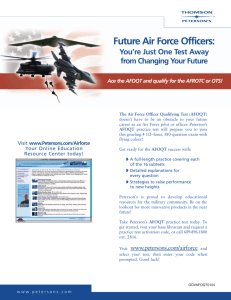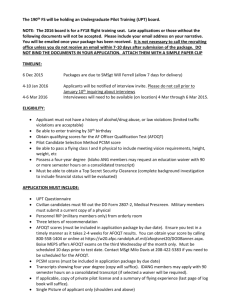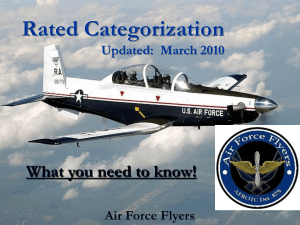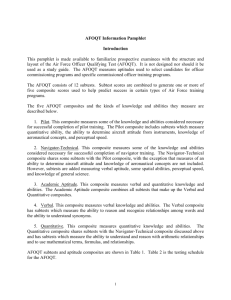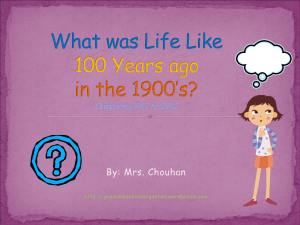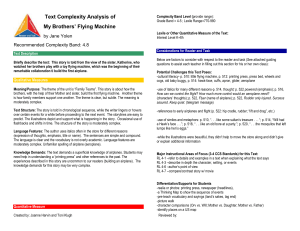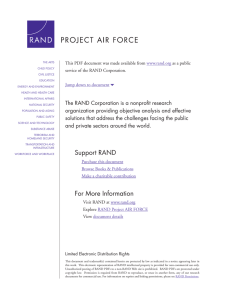Pilot Candidate Selection Method (PCSM) Program Status 16 May
advertisement
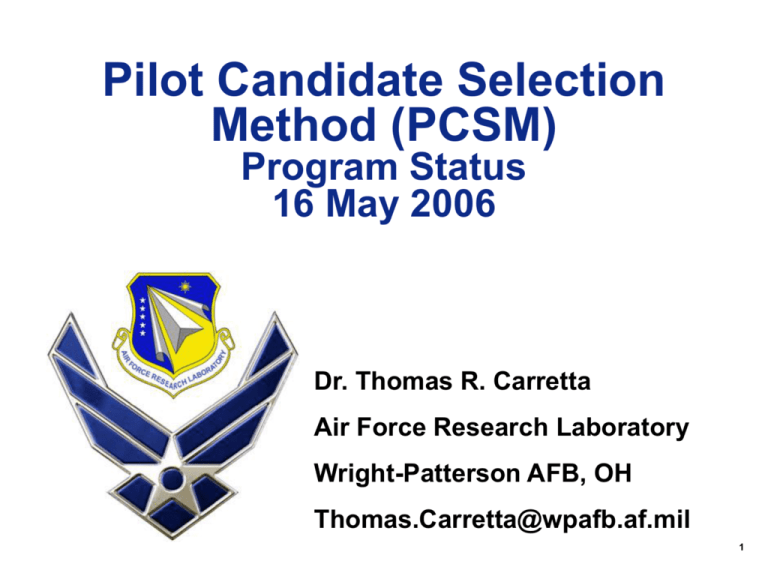
Pilot Candidate Selection Method (PCSM) Program Status 16 May 2006 Dr. Thomas R. Carretta Air Force Research Laboratory Wright-Patterson AFB, OH Thomas.Carretta@wpafb.af.mil 1 Pilot Candidate Selection Method • Psychomotor • Cognitive • Attitudes Air Force Officer Qualifying Test + • PCSM is a regressionweighted pilot aptitude composite • Operationally implemented by USAF in 1993 + • Cognitive ability • Aviation-related knowledge Basic Attributes Test Previous Flying Experience 2 T-37 Outcome by PCSM Quartile 700 64.1% Grad 89.3% Grad Frequency (N) 600 500 400 Eliminees Graduates 300 200 100 0 1-25 26-50 51-75 76-99 PCSM Score N = 1,268 Grad %: 58.5% 69.7% 81.8% 92.1% 3 PCSM Changes • All three PSCM components are undergoing change • Air Force Officer Qualifying Test – July 2005: Form S implemented; dropped 5 of 16 subtests and created new composites • Basic Attributes Test – July 2006: Scheduled to be phased out and replaced with the Test of Basic Aviation Skills (TBAS) • Flying Experience – Flight screening program has undergone several changes since 1993 4 AFOQT (Forms O, P1/P2, &Q1/Q2) • Paper-and-pencil test • Approximately 380 items in 16 subtests are combined into 5 composites: – – – – – • • Verbal Quantitative Academic Aptitude (Verbal + Quantitative) Pilot Navigator/Technical 1978 norms based on active duty population New form implemented approximately every 8 years 5 AFOQT (Forms O, P1/P2, & Q1/Q2) Composite ________________________________________ Verbal Quantitative Academic Pilot NavigatorAptitude Technical Test Abbr. (V) (Q) (AA) (P) (N-T) ________________________________________________________________________ Verbal Analogies VA X X X Arithmetic Reasoning AR X X X Reading Comprehension RC X X Data Interpretation DI X X X Word Knowledge WK X X Math Knowledge MK X X X Mechanical Comprehension MC X X Electrical Maze EM X X Scale Reading SR X X Instrument Comprehension IC X Block Counting BC X X Table Reading TR X X Aviation Information AI X Rotated Blocks RB X General Science GS X Hidden Figures HF X ________________________________________________________________________ Note. Abbr. means abbreviation. 6 AFOQT: What is Measured? g Verbal VA RC WK Math GS AR DI Spatial MK SR MC Percep. Speed Aviation EM BC RB HF IC AI TR 7 AFOQT: What is Measured? • Confirmatory factor analysis: – – – Like other cognitive tests, AFOQT has a hierarchical structure Higher-order factor is g 4% 9% 4% 4% 12% 5 lower-order factors: • • • • • Verbal 67% Math Spatial Aviation Knowledge Perceptual Speed g Verbal Math Spatial Aviation Per. Spd. 67% of the common (explained) variance is due to g 8 AFOQT: What is Predictive? • Olea & Ree (1994) examined the predictiveness of g, specific ability, and specific knowledge from the AFOQT for pilot trainees (N = 1,867 to 3,942) – Predictors were unrotated principle components from AFOQT – Training criteria included academic grades, check flight grades, an overall performance composite, and a passing/failing score – g was the best predictor for all pilot training criteria. The average validity of g was .31 – Specific knowledge (IC & AI tests) showed incremental validity beyond g of .098 – Specific ability (verbal, math, spatial, perceptual speed) showed little increment to g, about .02 9 AFOQT Form S • Goals: – Reduce test administration time – Maintain composite score reliability and validity – Retain previous factor structure (verbal, quantitative, spatial, aviation knowledge, perceptual speed) – No adverse impact due to changes in battery • Results: – Dropped 5 subtests reducing administration time from 4.5 to 3 hours (RC, DI, MC, EM, SR) – Retained reliability and validity of composites as well as factor structure – Added Self-Description Inventory (SDI+) to assess personality factors (resultant test is 3.5 hours) 10 AFOQT Form S Reliability & Validity Effects • Intercorrelations between old and new Composites Form Q • Form R /S Verbal .97 .96 Quant .97 .98 Acad Apt .98 .98 Pilot .97 .92 Nav-Tech .98 .94 Little reliability or correlation loss caused by removing RC, DI, MC, EM, and SR • Validity of new Pilot composite versus T-37 performance was comparable to old Pilot composite 11 AFOQT Form S Composite ______________________________________ Test Abbr V Q AA P N/T _________________________________________________________________________ Verbal Analogies VA X X Arithmetic Reasoning AR Word Knowledge WK Math Knowledge MK Instrument Comprehension IC Block Counting BC Table Reading TR X Aviation Information AI X General Science GS Rotated Blocks RB Hidden Figures HF Self-Description Inventory SDI+ X X X X X X X X X X X X X X X 12 AFOQT Form S Self-Description Inventory (SDI+) • Personality inventory based on Goldberg (1990) adjective clusters – 220 items consisting of trait descriptions (behavioral statements) – Captured Big Five personality dimensions and 2 additional factors – Service Orientation (SO) & Team Orientation (TO) • SO – organizational commitment • TO – preferences for working as member of a group or working alone – Subsequent factor analysis confirmed Big Five factors and Service Orientation factor • Team-Orientation factor not separate from other factors • Proposed to be used for career counseling 13 Basic Attributes Test (BAT) • Basic Attributes Test (BAT) measures: – Psychomotor – Cognitive – Personality/Attitudes • In operational use since 1993 – 386-based computer – Test hardware can no longer be maintained – To be replaced by the Test of Basic Aviation Skills (TBAS) 14 Test of Basic Aviation Skills (TBAS) • Test of Basic Aviation Skills (TBAS) measures: – – – – Psychomotor Cognitive (spatial) Multi-task performance Memory • Unlike BAT, several TBAS subtests are related to one another • Scheduled for operational implementation in July 2006 15 TBAS Status • Preliminary TBAS-based PCSM scoring algorithm completed – A regression-weighted composite was developed using AFOQT, flying experience, & TBAS scores – TBAS scoring algorithm designed to counter test-taking strategies (e.g., concentrate on part of multiple-task test) – Predictive validity is comparable to BAT-based PCSM equation • Ongoing tasks – Development of test materials (e.g., operator’s manual, examinee information pamphlet) – Compliance with professional test standards (e.g., APA) – Deployment of test equipment – Development of long-term sustainment plan 16 Flying Experience • PCSM Flying Hour Code is an unequal interval scale based on examination of relation of previous flying hours with UPT performance • Code categories: – – – – – – – – – – 0: 0 flying hours 1: 1 to 5 flying hours 2: 6 to 10 flying hours 3: 11 to 20 flying hours 4: 21 to 40 flying hours 5: 41 to 60 flying hours 6: 61 to 80 flying hours 7: 81 to 100 flying hours 8: 101 to 200 flying hours 9: 201 and Up flying hours 17 Flying Experience • Prior to 1994: Flight Screening Program – – 15 to 20 hours in T-41 Conducted by USAF at USAFA and Hondo, TX • 1994-1997: Enhanced Flight Screening Program – – – 21 hours in T-3 (Slingsby Firefly) & included more aerobatic training Conducted by USAF at USAFA and Hondo, TX Discontinued following several uncommanded engine stoppages • 1997-1998: No flight screening program • 1998: Introductory Flight Training Program – – • Syllabus expanded to 40, then 50 hours Taught at Civilian training schools Present: Introductory Flight Screening Program – 25 hours conducted by contractor instructors 18 Future Directions • TBAS-based PCSM post-implementation S&T issues – Subgroup differences – Test-retest performance – Extension of PCSM to other career fields (e.g., UAV operators) • • Examine utility of AFOQT SDI+ for career counseling Collaboration with the US Navy – TBAS and iTBAS (internet TBAS) comparability – Examine relations between USAF and USN officer commissioning & aircrew selection tests • Development of common test battery – Computer-administered AFOQT 19 Questions? 20 AFOQT 1. Verbal Analogies DIRECTIONS: This part of the test measures your ability to reason and see relationships between words. You are to decide the answer that best completes the analogy developed at the beginning of each question. 1. FINGER is to HAND as TOOTH is to _____. a. tongue b. lips c. nose d. mouth e. molar 2. RAQUET is to COURT as __________. a. tractor is to field b. blossom is to bloom c. stalk is to prey d. plan is to strategy e. moon is to planet 3. FLY is to AIRPLANE as __________. a. drive is to stake b. skate is to slide c. push is to fall d. swim is to float e. rod is to hook 21 AFOQT 2. Arithmetic Reasoning DIRECTIONS: This part of the test measures mathematical reasoning. It is concerned with your ability to arrive at solutions to problems. Each problem is followed by 5 possible answers. Decide which of the 5 answers is most nearly correct. 1. If an aircraft travels at 564 miles per hour, how many miles did the aircraft fly in 900 seconds? a. 141 b. 226 c. 300 d. 451 e. 846 2. A typist took 3 typing tests. The average typing speed on these tests was 48 words per minute (WPM). If the typists speed on 2 of these tests was 52 WPM, what was the speed on the third test in WPM? a. 38 b. 40 c. 42 d. 44 e. 46 22 AFOQT 3. Word Knowledge DIRECTIONS: This part of the test measures verbal comprehension involving your ability to understand written language. For each question, choose the answer that means the same as the capitalized word. 1. CRIMSON a. crisp b. neatly dressed c. reddish d. colorful e. lively 2. CEASE a. start b. change c. continue d. stop e. fold 3. FORTNIGHT a. 2 days b. 1 week c. 2 weeks d. 1 month e. 2 months 4. TERSE a. pointed b. trivial c. oral d. lengthy e. raggedy 23 AFOQT 4. Math Knowledge DIRECTIONS: This part of the test measures your ability to use learned mathematical relationships. Each problem is followed by 5 possible answers. Decide which one of them is most nearly correct. 1. The first digit of the square root of 59463 is: a. 1 b. 2 c. 3 d. 4 e. 5 2. The distance in miles around a circular course with a radius of 35 miles is (use = 22/ 7): a. 110 b. 156 c. 220 d. 440 e. 880 3. Solve for x: 2x/ 7 = 2x2 a. 1/ 7 b. 2/ 7 c. 2 d. 7 e. 14 24 AFOQT 5. Instrument Comprehension DIRECTIONS: This test measures your ability to determine the position of an airplane in flight from reading instruments showing its compass heading, amount of climb or dive, and degree of bank to right or left. 25 AFOQT 6. Block Counting DIRECTIONS: This is a test of your ability to “see into” a 3-dimensional pile of blocks and determine how many pieces are touched by certain numbered blocks. All of the blocks in a pile are the same size and shape. 26 AFOQT 7. Table Reading DIRECTIONS: This test measures your ability to read tables quickly and accurately. In the table below, the X values are indicated at the top and the Y values at the left. In this test, you are to find the table entry that corresponds to a given set of row (X) and column (Y) values. 1. For X = 0 and Y = -1: a. 29 b. 32 c. 33 d. 34 e. 35 2. For X = -3 and Y = -3: a. 22 b. 23 c. 28 d. 29 e. 31 3. For X = -1 and Y = +2: a. 25 b. 27 c. 29 d. 30 e. 31 4. For X = +3 and Y = 0: a. 30 b. 34 c. 35 d. 37 e. 39 27 AFOQT 8. Aviation Information DIRECTIONS: This part of the test measures your aviation knowledge. Decide which of the choices best answers the question or completes the statement. 1. If the elevator tabs on a plane are lowered, the plane will tend to: a. nose up b. nose down c. pitch fore and aft d. go into a slow roll e. wing over 2. The pilot always advances the throttle during a: a. nose dive b. landing c. turn d. spin e. climb 3. The slipstream of an airplane will have the least effect on the plane’s direction of flight when the plane’s: a. stick is moved forward b. stick is moved backward c. stick is moved sideways d. rudder bar is pressed with the left foot e. rudder bar is pressed 28 with the right foot AFOQT 9. General Science DIRECTIONS: This part of the test measures your knowledge in the area of science. Decide which one of the choices best answers the question or completes the statement. 1. An eclipse of the sun throws the shadow: a. moon on the earth b. earth on the sun c. sun on the earth d. earth on the moon e. moon on the sun 2. Lack of iodine is often related to which of the following diseases? a. Beriberi b. Scurvy c. Rickets d. Goiter e. Asthma 3. After adding salt to water, the freezing point of the water is: a. variable b. inverted c. unchanged d. raised e. lowered 29 AFOQT 10. Rotated Blocks DIRECTIONS: This test measures your ability to visualize and manipulate objects in space. In each item, you will be shown a picture of a block. The problem is to find a second block that is identical to the first. 30 AFOQT 11. Hidden Figures DIRECTIONS: This part of the test measures your ability to locate a simple geometric figure embedded in a complex drawing. Your task is to determine which lettered figure (A, B, C, D, or E) is contained in each numbered drawing. 31 AFOQT 12. Self Description Inventory DIRECTIONS: This inventory measures personal traits and attitudes. The inventory consists of a list of statements. The task is to read each statement carefully and decide how well each one describes you. Look at the sample statement below. S1. I enjoy reading poetry. Decide if statement S1 is characteristic of you and indicate your agreement using the scale below. A – Strongly Disagree B – Moderately Disagree C – Neither Agree nor Disagree D – Moderately Agree E – Strongly Agree 32 BAT 1. Two-Hand Coordination • Rotary pursuit tracking task • Target moves in a fixed, elliptical pattern at varying speeds • Task is to keep gunsight on target using control sticks • Test length ~10 minutes. 33 BAT 2. Complex Coordination • Compensatory tracking task • Dual-axis control stick is used to keep the small cross centered on the large cross • Single-axis control stick is used to keep the rudder bar centered at the bottom of the screen • Test length ~10 minutes. 34 BAT 4. Time Sharing • Assesses control precision and reaction time • Combines a compensatory tracking task with a target identification (digit canceling) task • Test length ~30 minutes 35 BAT 3. Item Recognition • Assesses short-term memory • A string of 1 to 6 digits is presented quickly, removed, and replaced by a single digit • Examinee must determine if single digit presented was also present in the original string • Test length ~20 minutes 36 BAT 5. Activities Interest Inventory • Assesses attitudes toward risktaking • Examinee is presented with activity pair and asked to choose between the activities • Activity pairs differ in level of risk • Test length ~10 minutes 37 TBAS 1. UAV Directional Orientation • Assesses spatial orientation • Examinee must determine position of target relative to the UAV – The "tracker map” shows the examinee the location and heading of the UAV • Example “select the North parking lot” 38 TBAS 2 & 3. 3-Digit and 5-Digit Listening • A string of letters and numbers is presented over headphones • Task is to squeeze the trigger when any of three (3) or five (5) pre-specified target numbers are presented • Test length = 60 seconds 39 TBAS 4. Horizontal Tracking • Compensatory tracking task • Use rudder pedals to keep the yellow box over a moving airplane target • Speed of the moving target increases during test • Test length = 60 seconds 40 TBAS 5.Airplane Tracking • Compensatory tracking task • Dual-axis joystick is used to keep the yellow sight over a moving airplane target • Test length = 60 seconds 41 TBAS 6. Airplane & Horizontal Tracking • Compensatory tracking task • Combines Airplane Tracking Task and Horizontal Tracking Task • Time length = 120 seconds 42 TBAS 7 & 8. Airplane & Horizontal Tracking & Listening • • Compensatory tracking task and listening task • Time length = 180 seconds Combines Airplane Tracking Task and Horizontal Tracking Task with either 3-Digit Listening or 5-Digit Listening tasks 43 TBAS 9. Emergency Scenario • Compensatory tracking & memorization • Target digit listening is replaced with emergency scenarios task – Examinee must resolve “emergency situations” by entering code memorized earlier from test instructions 44
